SUMMARY
This is AI generated summarization, which may have errors. For context, always refer to the full article.
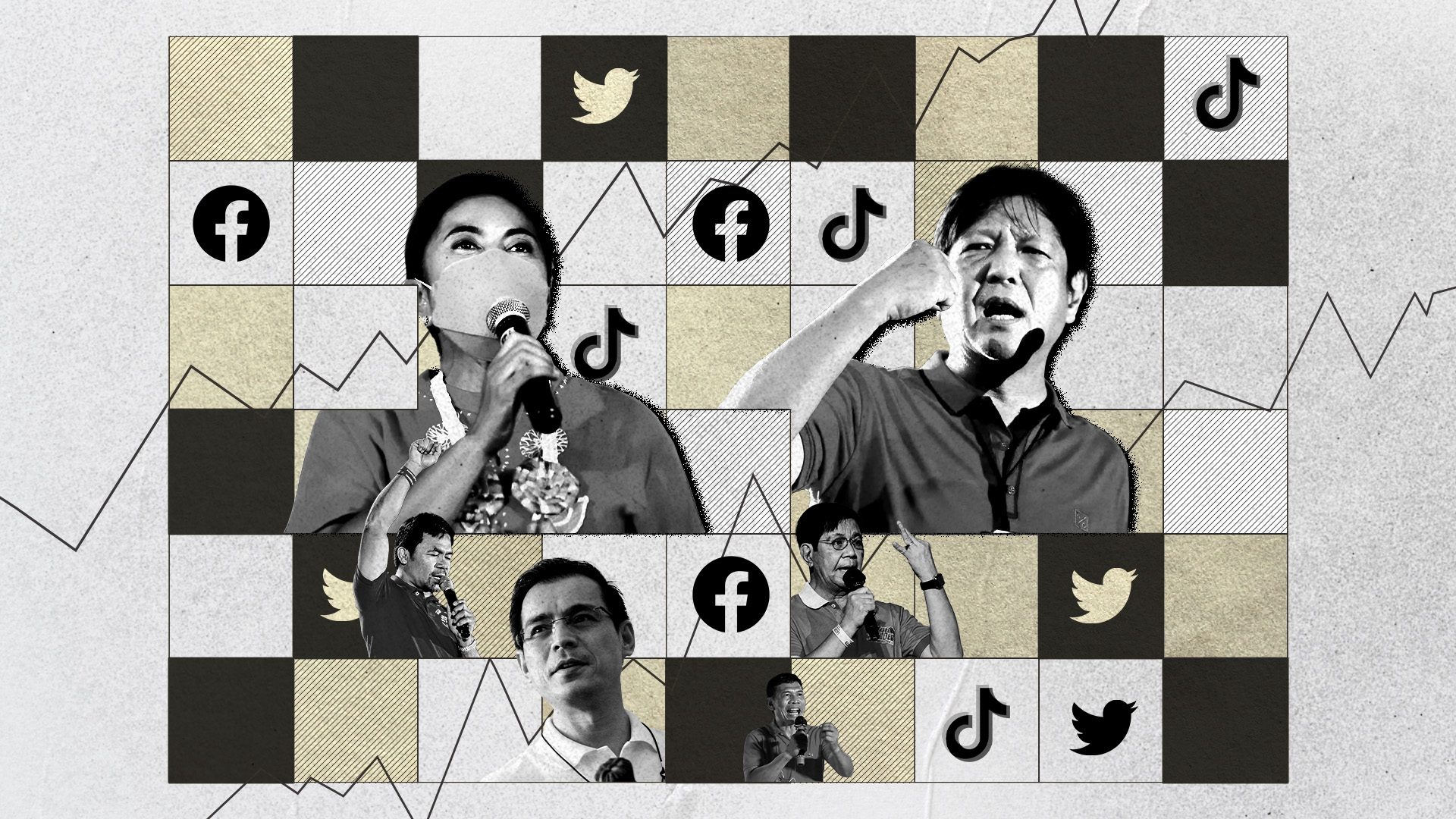
This story was made in collaboration with data consultancy TheNerve.
At a glance
- Data analysis of election-related posts on Facebook, Twitter, and TikTok showed that among the 10 presidential candidates for the 2022 elections, Ferdinand “Bongbong” Marcos Jr. and Leni Robredo dominate the conversations online.
- Robredo slightly leads over Marcos in terms of total mentions on Facebook, but these aren’t necessarily all from pro-Leni communities. Her network shows a huge presence of shared communities, likely due to her campaign’s efforts to penetrate neutral spaces – an attempt to reach out of their echo chambers and convert.
- Marcos has the most well-coordinated network on Facebook among all of the candidates. His community operates in a vacuum, effectively drowning out content from sources other than those supportive of him.
- A big proportion of supporters in Marcos’ network indicates that the years-long information operations online have successfully created a massive echo chamber of Marcos family supporters. But the growth of Robredo’s volunteer-driven network on the platform is trying to challenge this.
- Robredo is winning by a mile on Twitter. Election-related conversations on Twitter are largely from pro-Robredo communities. Although Marcos has a distinct cluster on Twitter, his community is mainly composed of new accounts.
- Marcos dominates TikTok, a fast-growing platform that is also hounded by rampant disinformation.
MANILA, Philippines – In the social media arena, it’s a two-way race between former senator Ferdinand “Bongbong” Marcos Jr. and Vice President Leni Robredo for the 2022 presidential election.
Marcos and Robredo, the consistent top 2 in the pre-election surveys since the filing of candidacies in October 2021, also dominate Facebook, Twitter, and TikTok. But unlike in the surveys where Marcos enjoys a wide lead over Robredo, the race appears to be tighter on social media.
As the Philippines moves to elect a new leader in 2022, Rappler looked at how the candidates and their supporters have utilized social media for their campaigns.
Rappler and Manila-based data consultancy Nerve scanned Facebook for public posts from accounts, consisting of pages and groups, that contained terms specific to the presidential candidates of the 2022 elections – including their names, campaign taglines, and the name of their respective supporter groups. The same was done on TikTok. The scan was done from February to March 2022.
On Facebook, network community clustering of the accounts and natural language processing (NLP) were done for further analysis.
Graphika, a US-based independent social analytics firm, conducted a similar scan on Twitter to capture the Philippine election landscape on the platform. Its scope is from February 20 until March 22, 2022.
A two-way race
(Please allow time for the data visualization to load)
Robredo had the most mentions on Facebook, with Marcos closely following behind. This means that Robredo was the most talked about on the platform among all 10 candidates. The other eight candidates trailed far behind.
But Robredo’s lead doesn’t necessarily mean that she’s winning on the platform since not all of the conversations about her were coming from pro-Leni communities. To further make sense of the nature of the conversations, a representative sample of the Facebook accounts found in the scan were clustered based on the similarity of the sources they shared. The clustering showed only three main communities: Robredo supporters, Marcos supporters, and Moreno supporters as a far third.
The map above shows that the Robredo network is sharing from a much more diverse set of sources than other candidates – their campaign’s own content, celebrity supporters, mainstream media, and even fact checkers. In contrast, the Marcoses’ massive networks of supporters are sharing from a more limited set of sources, usually those that focus on pro-Marcos propaganda, such as alternative news sites and pro-Marcos bloggers, staying away from mainstream media sources.
Moreno’s community is relatively smaller and seems to focus on amplifying content coming from Moreno’s page itself, rather than other sources. His campaign efforts seem to leverage his and his running mate Willie Ong’s own influencer-like assets on social media, instead of tapping other voices online.
On Twitter, the accounts found in the scan were grouped into clusters based on the similarity of the accounts they follow. Graphika’s data shows that the pro-Robredo cluster (21.4%) is bigger than the pro-Marcos (7.62%) and pro-Duterte (9.16%) clusters combined.
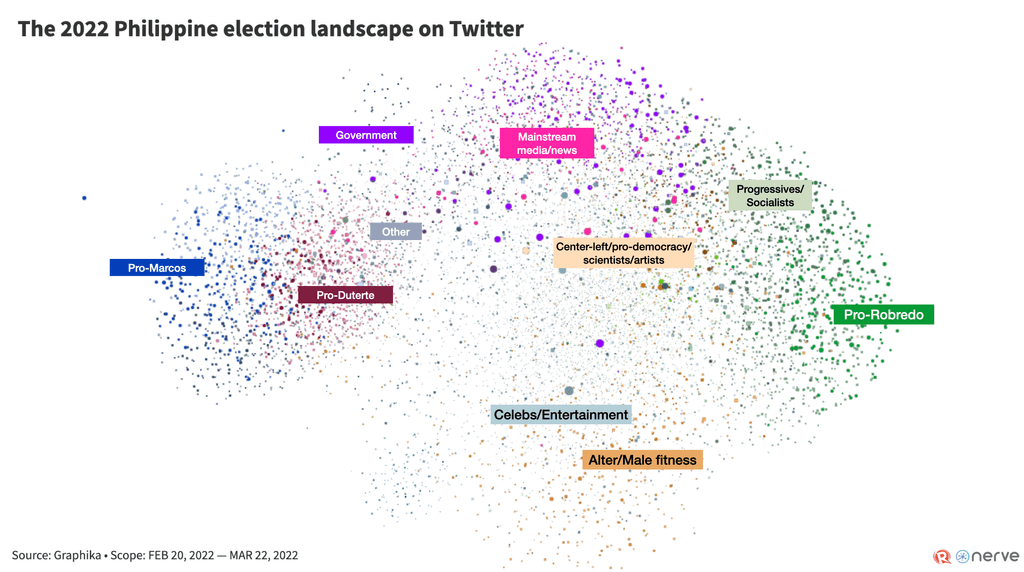
The TikTok scan showed the same pattern. Posts that mentioned Marcos and Robredo, regardless of the sentiment, had the highest volume. Moreno was also a far third on TikTok.
All 10 presidential candidates were included in the scans. On Facebook and TikTok, the data for Marcos, Robredo, Moreno, Manny Pacquiao, Ping Lacson, and Leody de Guzman were enough to compare them to each other. However, data for the four other candidates – Ernesto Abella, Norberto Gonzales, Faisal Mangondato, and Jose Montemayor Jr. – were relatively smaller and were not comparable enough to those of the other candidates.
On Twitter, the campaigns of other candidates apart from Robredo and Marcos were virtually nonexistent.
Facebook narratives and networks
The accounts talking about the candidates on Facebook were analyzed based on their sharing behavior and were clustered into communities sharing from the same sources. This method would usually show three types of communities: pro-candidate communities that mostly share from sources in favor of the candidate, anti-candidate communities that share mostly from sources that are against the candidate, and shared communities that include both pro and anti entities amplifying content from more neutral sources, like news organizations.
The analysis showed that the networks of Marcos and Moreno both have a bigger proportion of pro clusters in their networks than their respective shared and anti clusters, while Robredo’s network showed a bigger shared cluster.
Marcos has benefitted the most on Facebook among all of the candidates. His community is big and well-coordinated, and the pro cluster (71%) dwarf the shared (26%) and anti (2.54%) clusters in his network.
Marcos’ network is like a huge, impenetrable fortress of supporters that amplify each other. The sources in his community are mostly loyalist groups and pages, which are then shared by other supporters. The network essentially exists in a vacuum, where pro-Marcos propaganda drowns out outsider facts and opinions.
Using NLP, data showed that the posts in his network were mostly composed of positive content surrounding his campaigning activities, pre-election survey results, and celebrities’ and local candidates’ endorsements. The messaging revolved around his potential projects, which were often presented with good intentions similar to his father’s – although many of these narratives contained exaggerated and false claims that often benefited him, such as lies about his qualifications and achievements.
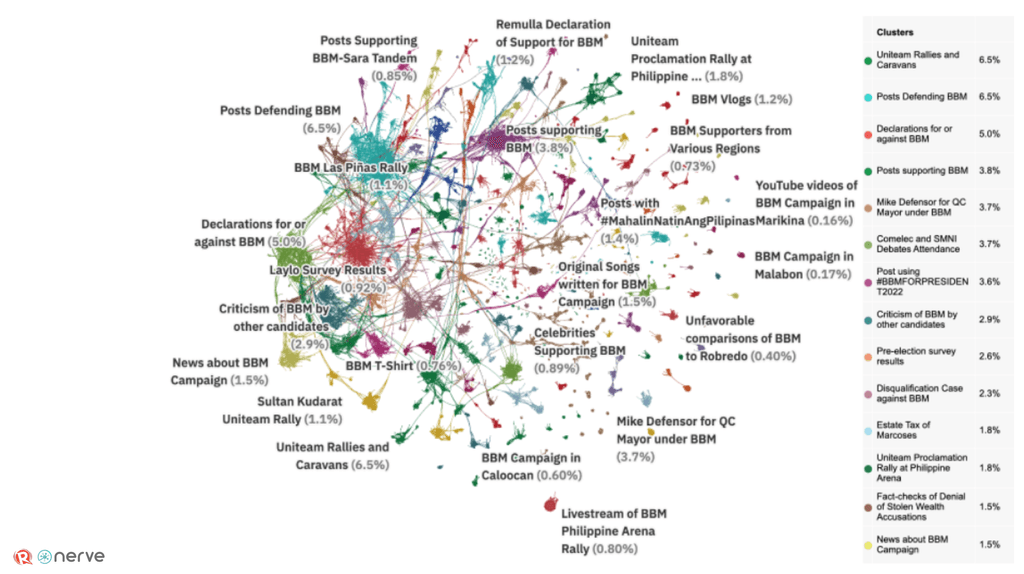
This massive echo chamber, built as early as 2014, makes it harder for fact checks and other content not favorable to the Marcoses to penetrate. The network provides all the content a Marcos supporter would want to see: they have alternative news sites for “news”, opinion and thought leadership from pro-Marcos bloggers, and even memes and entertainment. The low presence of shared communities in the network shows a support base that rarely subscribes outside their in-group.
Supporters of other candidates, particularly that of Robredo, have also been critical of the Marcoses highlighting their lies and atrocities, but these have hardly hurt his network – as can be seen in the dwarfed anti community. In many cases, the attacks hurled against him were even used by his supporters as an opportunity to counterattack with more disinformation and insults, framing the Marcoses as the victims of falsehood.
In contrast, Robredo shows a big community of supporters on Facebook but they share from more diverse sources and attempt to break through online silos.
Unlike Marcos who has had a headstart with a huge network of supporters and disinformation machinery, Robredo tries to build a volunteer-driven network on Facebook that shares more organic content from a more diverse set of sources. Calls for volunteers and volunteer centers are unique to Robredo’s campaign, where different accounts interact with each other to operate more strategically both online and offline. Robredo is also able to rely on content from mainstream news organizations and fact checkers, making her network’s content sources more diverse compared to Marcos.
Robredo’s sorties that drew huge crowds also translated into online posts. The NLP showed that 14% of the total conversations in Robredo’s cluster were about her campaign rallies in different areas in the Philippines.

Interestingly, the strategy of the Robredo network on Facebook seems to be funneling content to more neutral spaces, in order to reach new people and cross boundaries, rather than engaging existing pro-Leni groups – which reflects their on the ground “tao-sa-tao” (person-to-person) approach.
Instead of a large cluster of supporters like Marcos’, Robredo’s network shows a huge presence of shared communities, likely due to her campaign’s efforts to penetrate neutral spaces – an attempt to reach out of their echo chambers and convert. Whether or not Robredo’s volunteer-driven network is able to grow fast enough and break through Marcos’ walls in time for the elections is an outcome yet to be seen.
Robredo has also been hounded by online attacks – including baseless claims that red-tagged her and misogynistic comments that belittled her intelligence. She has been a constant target of online disinformation. Fact-checking initiative Tsek.PH said that Robredo is the “biggest victim” of disinformation carrying negative messaging among all candidates.
Despite this, data showed that Robredo’s anti-cluster is smaller than her supporters. Her camp’s strategy of citing mainstream media, which also includes fact checkers, may be a factor why they have been able to defend themselves from the antagonistic posts.
Moreno’s community on Facebook, the third biggest overall, is unique because it reflects an influencer-like network where there are very few sources, a lot of sharers, and no true anti community – at least before he started going on an offensive against other candidates. Note that the scan was not able to capture the response to the Easter press conference where he called on Robredo to withdraw, after which he suffered a drop in the surveys.
Moreno’s influencer-like network may be attributed to Moreno’s branding as a celebrity politician whose campaign is built around himself, and where most of his announcements come from his own accounts. His running mate, Willie Ong, and wife Liza, also have a huge following on social media due to their content of easy-to-access medical advice. (READ: Almost victory: Doc Willie Ong’s OFW votes, social media support)
The conversations in Moreno’s network revolved around his accomplishments as a mayor. His background as the “Action Man” of Manila who improved the city through infrastructure projects and other policies dominated the conversations about him. His network also actively pushed the #SwitchToIsko campaign, as an attempt to woo the voters of Marcos and Robredo to his side.
Moreno’s red community, which the algorithm detected as distinct from the rest, is not necessarily anti but more of a neutral cluster that is composed of pages and groups sharing Moreno-related updates.
In contrast to the top 3 candidates on Facebook, the respective networks of Pacquiao, Lacson, and De Guzman all show small pro clusters that are dwarfed by their respective shared and anti-clusters. Their respective anti communities are composed of the top 3 candidates’ supporters.
Posts about Lacson’s platforms and campaigns drove the narratives for Lacson’s pro cluster, but it is outsized by his shared and anti communities. His anti-cluster shows a lot of Robredo-Pangilinan and Marcos-Duterte supporters. A main driver of the anti-posts against Lacson was his baseless accusation in early March that a presidential candidate’s campaign had been infiltrated by the communists. The accusation was seen to be directed at Robredo’s campaign.
Another major topic about Lacson online, which was Partido Reporma switching support to Robredo, was a huge loss on his campaign.
Pacquiao’s network is somewhat similar to Lacson’s in that it also only has a small pro community, which is composed of his supporters and boxing enthusiasts. He has an overwhelmingly large anti community composed of accounts supporting other candidates, particularly the Marcos-Duterte tandem. The most common antagonistic narratives about him include his low survey ratings and attacks on his intellect and qualifications.
De Guzman’s network also has a huge anti community, which is composed of accounts related to other candidates, including Robredo, Marcos, and Moreno supporters. This is because De Guzman has made controversial statements about women leaders and hurled criticisms against other candidates during his campaign, which displeased supporters of these other candidates.
He was also often falsely tagged as a communist because of his proposed solution to the country’s decades-long insurgency.
A different battlefield on Twitter
It’s also a two-way race on Twitter, but it’s an arena where Robredo is clearly winning over Marcos. Graphika’s data showed that election-related conversations on Twitter were largely from pro-Robrero communities.
Graphika detected the following clusters, from biggest to smallest: Celebrities and entertainment (31.14%), Pro-Robredo (21.4%), Pro-Duterte (9.16%), Pro-Marcos (7.62%), Progressives and socialists (6.55%), Center-left, pro-democracy, scientists, and artists (6.47%), Alter Twitter and male fitness (5.85%), Others (5.06%), Government (3.61%), and Mainstream media and news (3.13%).
The pro-Robredo community is bigger than both the pro-Duterte and pro-Marcos communities combined. Non-political clusters, like followers of celebrities/entertainment accounts, alter/male fitness influencers, and mainstream media, also lean more towards the pro-Robredo clusters – which means they are also more likely followers of pro-Robredo accounts. Meanwhile, the government cluster (followers of official government sources) gravitates more toward the Marcos-Duterte side.
The official Twitter accounts of other presidential candidates Moreno and Pacquiao were found at the center. This indicates that while they have no distinct community on the platform, they were still followed by accounts belonging to different clusters.
Robredo also dominates Twitter in terms of content. Eight out of the top 10 hashtags found in the scan were about Robredo, her campaign, and her sorties on-ground.
Top 10 Twitter hashtags found in the scan:
- #PasigLaban
- #LeniKiko2022
- #PasigIsPink
- #CNNPHPresidentialDebate
- #IpanaloNa10To
- #CaviteIsPink
- #KulayRosasAngBukas
- #PiliPinasDebates2022
- #10RobredoPresident
- #AngatBuhayLahat
Robredo is also the only presidential candidate that made it to the list of the 10 most mentioned users. Her running mate, Senator Kiko Pangilinan, is also the only vice presidential candidate on the list.
Although Robredo exhibited a wide lead on Twitter over Marcos and other candidates, it’s important to note that there are only 10.5 million users on the platform as of early 2022, according to We Are Social. This is far from the number of Facebook users in the country at 83.85 million.
Still, the Marcos network has attempted to penetrate Twitter but it has remained unsuccessful. Graphika’s data showed that while Marcos has a distinct cluster on Twitter that is closely tied to the cluster of pro-Duterte accounts, his community is smaller than Robredo’s and is mainly composed of new accounts.
Rappler’s earlier investigation found freshly-made accounts in October 2021, when Marcos filed his certificate of candidacy, spamming the platform to show support for Marcos. Twitter disclosed 3 days later that it had suspended over 300 accounts mentioned in the investigation for violating the company’s platform manipulation and spam policy.
The rising platform of TikTok
TikTok is a newer social media platform but We Are Social said it already has 35.96 million users in the Philippines as of early 2022. It has emerged as a key social media platform as more election-related videos were posted on the platform in the lead-up to May 2022. It also has increasingly become an avenue for disinformation.
Marcos dominates election-related talk on the platform, not only in the volume of videos mentioning him but also in average views, likes, comments, downloads, and shares per video. In terms of engagements, Robredo and Pacquiao follow closely in a virtual tie.
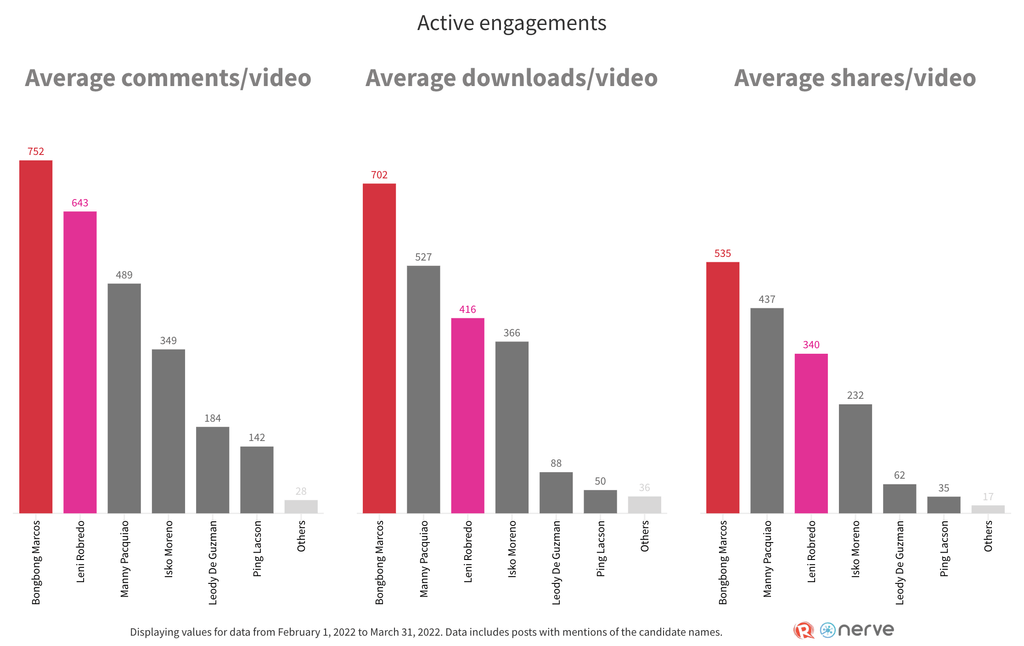

The videos found in the scan were then plotted in a graph to see their performance. Data showed that most TikToks with the highest shares and plays mentioned Marcos (46%). Another 26% mentioned Robredo, while 22% mentioned multiple candidates.
A related investigation by the Philippine Daily Inquirer published on April 27 found that Marcos’ lead on the platform may be attributed to the proliferation of disinformation. “There were videos whitewashing the atrocities committed during the Marcos dictatorship. But most of the top viewed videos about the Marcoses paint them as a likable, relatable family, with good looks and enviable lifestyles,” the report said.
Social media in Philippine elections
Using trends in social media is in no way a surefire method to identify the voting preferences of the people. After all, not every voter has access to the internet, nor all social media users are registered voters. More importantly, the actual elections take place on the ground.
But in the Philippines, which has been dubbed the social media capital of the world and where Facebook is essentially the internet, the on-ground campaign for the elections is just as loud and important as the online campaign.
President Rodrigo Duterte’s victory in the 2016 elections set the precedent for how the polls in the Philippines take place in the digital age. A huge force behind Duterte’s win six years ago was his digital campaign on social media, particularly on Facebook.
Marcos’ wide reach on social media and the big proportion of supporters in his community suggest that his family’s years-long information operations online has reaped its benefits. But the growth of Robredo’s volunteer-driven network, especially in the lead-up to the elections, is clearly challenging this.
Ultimately, the results of the 2022 elections will decide if Robredo’s more organic approach to campaigning has successfully caught up with and broken down Marcos’ massive army of supporters – both online and offline. – with reports from Patrisha Estrada, Dylan Salcedo, Iggy Franco, Jhaymar Garcia, Keith Yadao/Rappler.com
This story was made in collaboration with TheNerve, a Manila-based consultancy that specializes in analyzing data to bring forth powerful insights and narratives. Believing that data can deliver real-world impact, the company enables its partners across a wide range of industries to cut through the clutter and extract value and meaning from various datasets. The insights guide partners’ business decisions and help them engage with their communities better. Composed of a team of data scientists, business strategists, award-winning storytellers, and designers, the company is on a mission to transform data science into data relevance.
Add a comment
How does this make you feel?
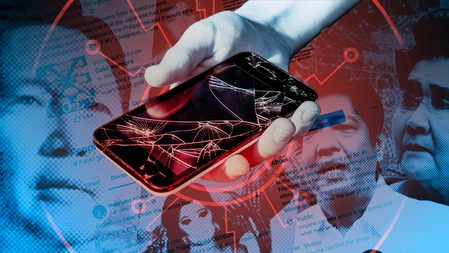
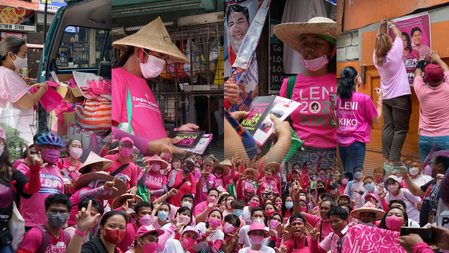
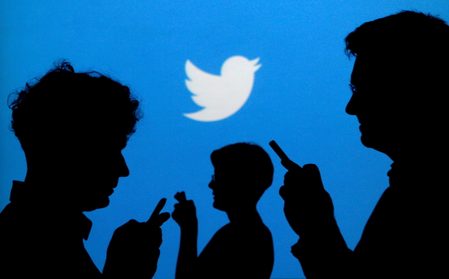
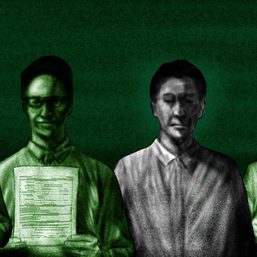
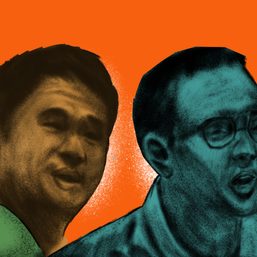
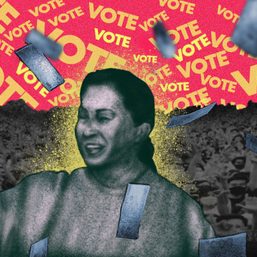
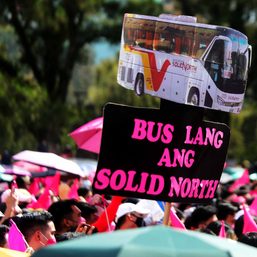
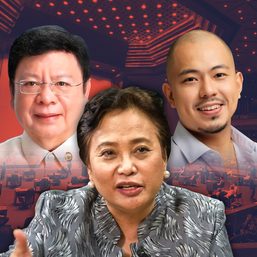


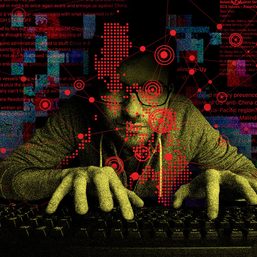
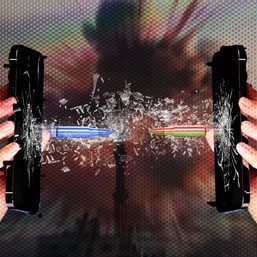
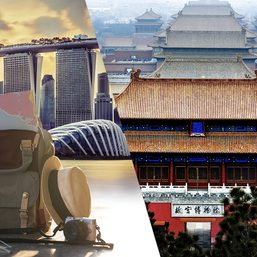
![[In This Economy] Marcos’ POGO ban is popular, but will it work?](https://www.rappler.com/tachyon/2024/07/thought-leaders-marcos-pogo-ban.jpg?resize=257%2C257&crop=255px%2C0px%2C720px%2C720px)
![[Rappler Investigates] POGOs no-go as Typhoon Carina exits](https://www.rappler.com/tachyon/2024/07/newsletter-graphics-carina-pogo.jpg?resize=257%2C257&crop=424px%2C0px%2C1080px%2C1080px)



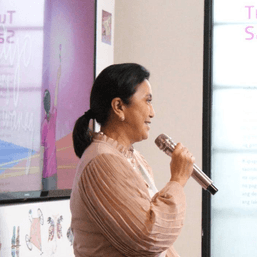

![[Newspoint] A fighting presence](https://www.rappler.com/tachyon/2024/07/thought-leaders-a-fighting-presence.jpg?resize=257%2C257&crop=441px%2C0px%2C1080px%2C1080px)
![[Closer Look] ‘Join Marcos, avert Duterte’ and the danger of expediency](https://www.rappler.com/tachyon/2024/06/TL-trillanes-duterte-expediency-june-29-2024.jpg?resize=257%2C257&crop_strategy=attention)

![[OPINYON] Tungkol sa naging viral na social media conjecture](https://www.rappler.com/tachyon/2024/07/thought-leaders-conjecture-07262024.jpg?resize=257%2C257&crop_strategy=attention)
![[DECODED] The Philippines and Brazil have a lot in common. Online toxicity is one.](https://www.rappler.com/tachyon/2024/07/misogyny-tech-carousel-revised-decoded-july-2024.jpg?resize=257%2C257&crop_strategy=attention)
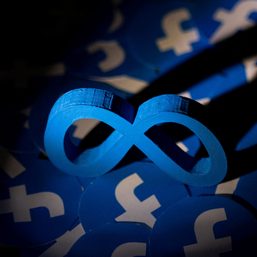

There are no comments yet. Add your comment to start the conversation.